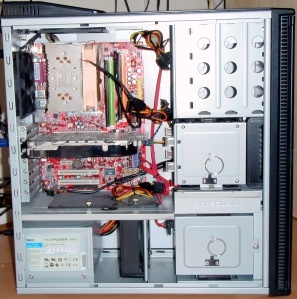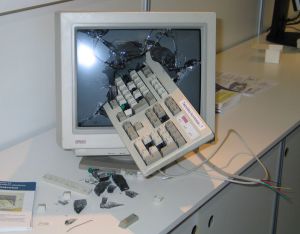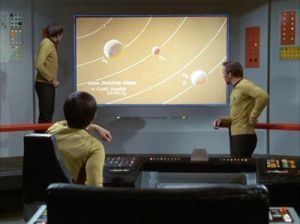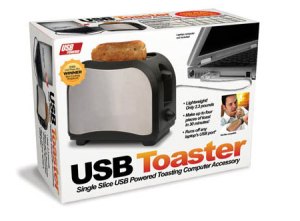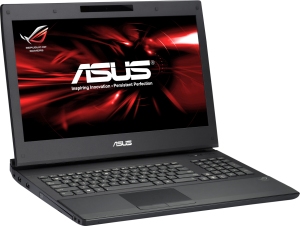There are people out there that can tell you how many gigawatts a flux capacitor needs to send your video card back to 1985 and then there are people who look at a computer and just want to know how to ”make it go.” Luckily, you don’t have to be Christopher Lloyd to be able to use a computer…it’s a lot easier than you think.
“When this baby boots up to Windows 3.1, you’re gonna see some serious shit.”
You’re looking to buy your first computer, whether you’re twelve and tired of the four hundred-dollar IPhoneTouchPadGalaxyThingyMabboboWhatsIts your parents bought you because you’re a spoiled brat or a senior citizen that still thinks that cassette tapes are the work of the devil.
First, you need to know what you’re buying. I’m talking basic level “insert widget A into screw you I’m too small hole B” physical peripherals.
Computer Case:
The computer case, often called a “tower” or “chassis”, holds almost everything you need to actually use the computer. It’s often a rectangular case filled with green electronic boards packed with resistors, capacitors, and other things you probably shouldn’t put in your mouth or any other orifice for that matter. Remember, warning labels serve as proof that some idiot tried doing it previously!
Never touch the insides of a computer case without first grounding yourself. You’ll thank me.
If you were to ever look inside one, you’d often see a large circuit board running along the opposite wall from which you opened the case. This is the brain of the computer, called the motherboard. It has many of the important parts your computer needs to function.
The ports you see on the back of your computer are often connected to smaller circuit boards or cards that are in turn connected to your motherboard. Video cards and ethernet cards are examples of these smaller circuit boards. Replacing a video card, for example, usually involves just swapping out the old card with a new, compatible card. Of course, there are a few more steps, but you get the idea.
The breaking of glass may or may not be one of those extra steps.
Computer cases come in various sizes. The larger cases usually allow the user to upgrade or add certain components to “make it go better”. Larger cases also allow for more features, like an extra drive bay for your CD / DVD / Blu-ray needs, extra slots for various card readers, and more. As you may have guessed, larger cases are a pain to move around should you need to do so. My five-year old Dell XPS gaming tower weighs up to seventy pounds. Mini-towers are available for those that don’t like using up that much space, however most are limited on how you can upgrade them and the space in which you have to work is smaller. Some choose to go the laptop route, but I’ll get into that later.
Monitor:
When Captain Kirk tells Lieutenant Sulu to put the alien ambassador onscreen, it’s so that he can see who he’s talking to in addition to sizing up the ambassador’s female aide that is sporting a toga made out of a shiny metallic fabric. The monitor, when connected properly to the computer case, displays the information the motherboard is producing. Monitors are output devices in that they cannot directly interact with the information stored in the computer. Monitors also come in various shapes and sizes just like televisions.
“Mr. Chekov…is it too late to switch back to Verizon?”
Make a note that when buying a computer, the monitor is often extra unless the price includes it as part of a special package. Some stores lump everything together into one nice box and other stores (mostly online) make you select the option to buy a monitor while building your computer case.
Monitors normally have two cords that must be plugged in to function. One is a power cord which plugs into a power strip or wall and the other is a colored plug that fits into a port on the back of your computer case. As you may have deduced, this port is connected to or is part of your video card.
Mouse & Keyboard:
As you previously learned, the computer case houses / processes the information and the monitor displays that information. The mouse & keyboard lets you interact with that information via buttons and sensory input.
Some are built with comfort in mind (like ergonomic varieties) and others are made for the bells and whistles (like keyboards that actually display output). Your standard mouse has about three buttons, though there are some that have fifteen plus. The latter mice are usually more expensive, but if you are playing a game that requires a lot of button mapping, it’s truly a mighty mouse.
Ba-Dum-Ch!
Both are connected to ports either in the front or in the back of your computer case. Most peripherals nowadays are connected via USB port, though some older brands still sport the round plug. If the latter, most computers color code the plug and the port so that they can be matched up easily.
Extras:
Then there are the extras. Printers let you print stuff. Scanners let you scan stuff. Fax machines let you fax stuff. External hard drives let you backup a large amount of data. USB sticks let you carry around a small amount of data, letting you “plug and play” on any computer that has a USB port on it, similar to that of what floppy disks used to do. Speakers let you hear sound. There are even USB gadgets that perform various functions, both useful and humorous.
Don’t leave home without it.
Most of these plug in via USB port, making connecting them simple.
Laptops:
Laptops are compact computers you can carry around with you. They are genuinely more expensive and harder to upgrade but worth it if you’re always on the go. A laptop has all of the basic functions of a desktop computer built in, including a monitor, touchpad mouse with buttons, keyboard, battery, and multiple ports for plug and play peripherals.
This particular article was brought to you by the Asus G73S, my current laptop.
Which is better, you ask? Most base their decision on preference and need. Some PC gamers prefer basking in the glow of their six hundred pound light strobing monolith and others prefer the pick up and go feature that laptops offer.
There you have it…the basics. Most of you more than likely already know about the above, but you’d be surprised how many people don’t know how to turn on a computer let alone describe what the motherboard does. Be on the lookout for a separate article that will cover useful tips when purchasing your very own PC. Until next time!


